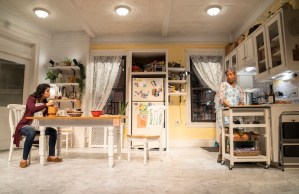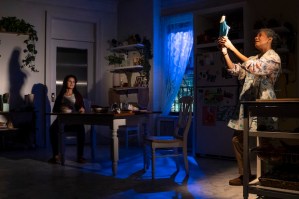Review: In Sancocho, Two Sisters Stew Over the Legacy of Their Dying Father
Christin Eve Cato’s two-hander makes its off-Broadway debut at the WP Theater.

(© Joan Marcus)
Death is a threshold, not just for the individual passing from life to death, but for the survivors who must determine the shape of their relationships to one another after that person is gone. That’s the negotiation we witness in Christin Eve Cato’s Sancocho, now making its off-Broadway debut at WP Theater in a co-production with Latinx Playwrights Circle and the Sol Project. Oscillating between riveting and sleepy, it’s a highly realistic depiction of kitchen-table politics and itchy family dynamics that become frozen and ignored, like so much leftover stew.
Throughout the 90-minute runtime, Caridad (Zuleyma Guevara) makes sancocho, specifically the recipe for the hearty stew that has been passed down through generations of their Puerto Rican family. Seven months pregnant with her first child, younger sister Renata (Shirley Rumierk) helps — but this is clearly Caridad’s kitchen.
Their father is in hospice and Caridad seems to be preparing the sancocho preemptively, knowing that she’ll need to serve something as she receives a stream of condolences. Eminently practical and hardened by age, she’s not as torn-up about his death as Renata is, and some of this can be explained by their very different childhoods.

(© Joan Marcus)
Unlike Caridad, Renata was born in New York, an oops baby 25 years her junior. She was lavished with all the trappings of the meritocracy: karate lessons, math tutoring, and a college education. And this put her on the path to becoming the successful attorney she is today.
Renata fondly remembers papi, but Caridad can only recall an abusive man who tortured their mother with his insecurities. “Oooh, he’s my daddy, and I love him and he always preferred me because I was the one who came out light skinned with pretty eyes,” Caridad mocks her sister, allowing her own resentment to pour out onto the kitchen floor. Long-held grudges are rehashed as family secrets are exhumed over peeled yuca and plantains.
Under the sensitive, detail-oriented direction of Rebecca Martínez, the two actors convey an authentic sisterly bond that complicates and illuminates their cultural divergence: As Caridad, Guevara has a seen-it-all weariness, a battle-tested chill reinforced by glass after glass of wine. Only her little sister seems capable to disrupting that, needling her with her Hallmark memories and fashionable manners (if anyone in this kitchen identifies as Latinx, it’s Renanta). Rumierk convincingly portrays a young member of the professional class who believes that happiness is her birthright and that she can always renegotiate for more.

(© Joan Marcus)
Their performances seem even more realistic on Raul Abrego’s meticulous set, complete with vintage cabinets, overstuffed shelves, and windows that look onto a battalion of brick buildings. María-Cristina Fusté’s lighting subtly pulls us into the evening, while Germán Martínez’s sound allows us to hear what the uncommonly perceptive Caridad hears, the one bit of magic in the play. Harry Nadal’s costumes give us an instant sense of the differences between the two sisters, both in age and lifestyle. Discovering the broth in which these two very different women have marinated is part of what makes Sancocho delightful.
It is sometimes too realistic for its own good, though. Cato painstakingly establishes the relationship between Caridad and Renata, sprinkling important bits of exposition in a sea of extraneous details. Like children lingering in the kitchen, only the most attentive audience members will catch everything. Unfortunately, the soothingly slow boil of the first half of the play practically invites our minds to wander. This two-hander also asks a lot of its actors, both of whom stumbled over multiple lines the evening I attended, suggesting extensive rewrites late in the process.
Despite its flaws, Sancocho is a worthwhile meditation on how people and events can be perceived very differently, and how that divergent outlook has the potential to sour a relationship. That doesn’t need to be the case: Sometimes seemingly inharmonious ingredients make for the best soup.









